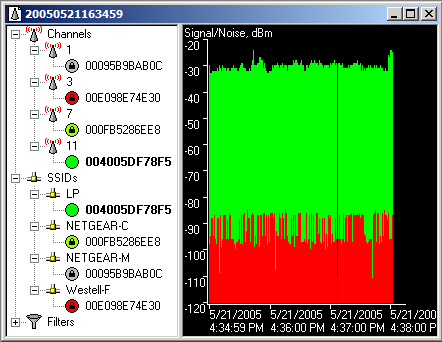Netstumbler has discoverd four access points, each transmitting on a different channel. The access points are identified by their 12-character media access (MAC) addresses. Every network interface device has a unique MAC address, assigned by the manufacturer.
Note that my neighbor's access points display small padlock icons. This indicates that they are set up to require passwords and encrypt traffic. My base station is open, and neighbors can use them, and, if they wish, they can read (sniff) my traffic.
The signal level is around -30 dBm, which is well above the -75 dBm sensitivity threshold of the radio in my laptop. For that reason, I remain stably associated with my access point.
With such a strong signal, the radios can communicate at a raw data rate of 11 mbps. If the signal level were to drop for some reason, the radios might have to switch to a more conservative modulation method, thereby slowing transmission. The WiFi protocol specifies that transmission slows down when the signal strength falls below specified thresholds. It can drop as low as 1 mbps before losing connectivity.
Note that each access point has a service set identifier (SSID) which identifies the network. You can think of it as the network name, and all devices communicating on the network must share that SSID.
